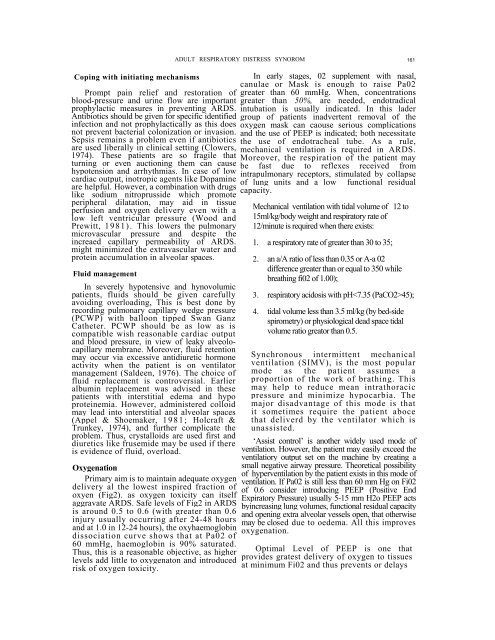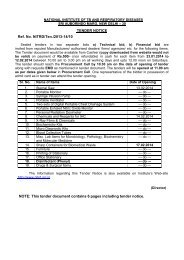October - LRS Institute of Tuberculosis & Respiratory Diseases
October - LRS Institute of Tuberculosis & Respiratory Diseases
October - LRS Institute of Tuberculosis & Respiratory Diseases
Create successful ePaper yourself
Turn your PDF publications into a flip-book with our unique Google optimized e-Paper software.
Coping with initiating mechanisms<br />
Prompt pain relief and restoration <strong>of</strong><br />
blood-pressure and urine flow are important<br />
prophylactic measures in preventing ARDS.<br />
Antibiotics should be given for specific identified<br />
infection and not prophylactically as this does<br />
not prevent bacterial colonization or invasion.<br />
Sepsis remains a problem even if antibiotics<br />
are used liberally in clinical setting (Clowers,<br />
1974). These patients are so fragile that<br />
turning or even auctioning them can cause<br />
hypotension and arrhythmias. In case <strong>of</strong> low<br />
cardiac output, inotropic agents like Dopamine<br />
are helpful. However, a combination with drugs<br />
like sodium nitroprusside which promote<br />
peripheral dilatation, may aid in tissue<br />
perfusion and oxygen delivery even with a<br />
low left ventricular pressure (Wood and<br />
Prewitt, 1981). This lowers the pulmonary<br />
microvascular pressure and despite the<br />
increaed capillary permeability <strong>of</strong> ARDS.<br />
might minimized the extravascular water and<br />
protein accumulation in alveolar spaces.<br />
Fluid management<br />
In severely hypotensive and hynovolumic<br />
patients, fluids should be given carefully<br />
avoiding overloading, This is best done by<br />
recording pulmonary capillary wedge pressure<br />
(PCWP) with balloon tipped Swan Ganz<br />
Catheter. PCWP should be as low as is<br />
compatible wish reasonable cardiac output<br />
and blood pressure, in view <strong>of</strong> leaky alveolocapillary<br />
membrane. Moreover, fluid retention<br />
may occur via excessive antidiuretic hormone<br />
activity when the patient is on ventilator<br />
management (Saldeen, 1976). The choice <strong>of</strong><br />
fluid replacement is controversial. Earlier<br />
albumin replacement was advised in these<br />
patients with interstitial edema and hypo<br />
proteinemia. However, administered colloid<br />
may lead into interstitial and alveolar spaces<br />
(Appel & Shoemaker, 1981; Holcraft &<br />
Trunkey, 1974), and further complicate the<br />
problem. Thus, crystalloids are used first and<br />
diuretics like frusemide may be used if there<br />
is evidence <strong>of</strong> fluid, overload.<br />
Oxygenation<br />
Primary aim is to maintain adequate oxygen<br />
delivery al the lowest inspired fraction <strong>of</strong><br />
oxyen (Fig2). as oxygen toxicity can itself<br />
aggravate ARDS. Safe levels <strong>of</strong> Fig2 in ARDS<br />
is around 0.5 to 0.6 (with greater than 0.6<br />
injury usually occurring after 24-48 hours<br />
and at 1.0 in 12-24 hours), the oxyhaemoglobin<br />
dissociation curve shows that at Pa02 <strong>of</strong><br />
60 mmHg, haemoglobin is 90% saturated.<br />
Thus, this is a reasonable objective, as higher<br />
levels add little to oxygenaton and introduced<br />
risk <strong>of</strong> oxygen toxicity.<br />
ADULT RESPIRATORY DISTRESS SYNOROM 161<br />
In early stages, 02 supplement with nasal,<br />
canulae or Mask is enough to raise Pa02<br />
greater than 60 mmHg. When, concentrations<br />
greater than 50%, are needed, endotradical<br />
intubation is usually indicated. In this lader<br />
group <strong>of</strong> patients inadvertent removal <strong>of</strong> the<br />
oxygen mask can caouse serious complications<br />
and the use <strong>of</strong> PEEP is indicated; both necessitate<br />
the use <strong>of</strong> endotracheal tube. As a rule,<br />
mechanical ventilation is required in ARDS.<br />
Moreover, the respiration <strong>of</strong> the patient may<br />
be fast due to reflexes received from<br />
intrapulmonary receptors, stimulated by collapse<br />
<strong>of</strong> lung units and a low functional residual<br />
capacity.<br />
Mechanical ventilation with tidal volume <strong>of</strong> 12 to<br />
15ml/kg/body weight and respiratory rate <strong>of</strong><br />
12/minute is required when there exists:<br />
1. a respiratory rate <strong>of</strong> greater than 30 to 35;<br />
2. an a/A ratio <strong>of</strong> less than 0.35 or A-a 02<br />
difference greater than or equal to 350 while<br />
breathing fi02 <strong>of</strong> 1.00);<br />
3. respiratory acidosis with pH45);<br />
4. tidal volume less than 3.5 ml/kg (by bed-side<br />
spirometry) or physiological dead space tidal<br />
volume ratio greator than 0.5.<br />
Synchronous intermittent mechanical<br />
ventilation (SIMV), is the most popular<br />
mode as the patient assumes a<br />
proportion <strong>of</strong> the work <strong>of</strong> brathing. This<br />
may help to reduce mean intrathoracic<br />
pressure and minimize hypocarbia. The<br />
major disadvantage <strong>of</strong> this mode is that<br />
it sometimes require the patient aboce<br />
that deliverd by the ventilator which is<br />
unassisted.<br />
‘Assist control’ is another widely used mode <strong>of</strong><br />
ventilation. However, the patient may easily exceed the<br />
ventilatiory output set on the machine by creating a<br />
small negative airway pressure. Theoretical possibility<br />
<strong>of</strong> hyperventilation by the patient exists in this mode <strong>of</strong><br />
ventilation. If Pa02 is still less than 60 mm Hg on Fi02<br />
<strong>of</strong> 0.6 consider introducing PEEP (Positive End<br />
Expiratory Pressure) usually 5-15 mm H2o PEEP acts<br />
byincreasing lung volumes, functional residual capacity<br />
and opening extra alveolar vessels open, that otherwise<br />
may be closed due to oedema. All this improves<br />
oxygenation.<br />
Optimal Level <strong>of</strong> PEEP is one that<br />
provides gratest delivery <strong>of</strong> oxygen to tissues<br />
at minimum Fi02 and thus prevents or delays
















